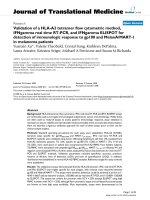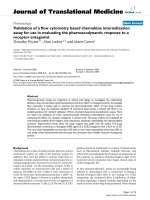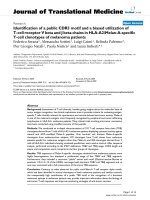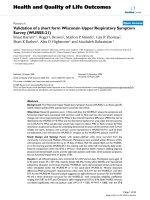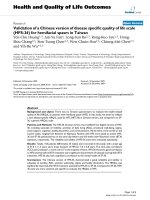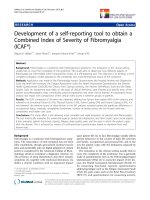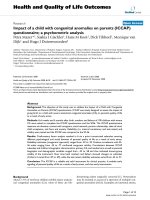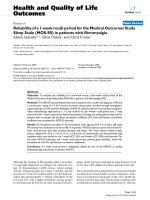Báo cáo hóa học: " Investigation of a new lead-free " docx
Bạn đang xem bản rút gọn của tài liệu. Xem và tải ngay bản đầy đủ của tài liệu tại đây (689.46 KB, 14 trang )
This Provisional PDF corresponds to the article as it appeared upon acceptance. Fully formatted
PDF and full text (HTML) versions will be made available soon.
Investigation of a new lead-free Bi0.5(Na0.40K0.10)TiO3-(Ba0.7Sr0.3)TiO3
piezoelectric ceramic
Nanoscale Research Letters 2012, 7:24 doi:10.1186/1556-276X-7-24
Pharatree Jaita ()
Anucha Watcharapasorn ()
Sukanda Jiansirisomboon ()
ISSN 1556-276X
Article type Nano Express
Submission date 6 September 2011
Acceptance date 5 January 2012
Publication date 5 January 2012
Article URL />This peer-reviewed article was published immediately upon acceptance. It can be downloaded,
printed and distributed freely for any purposes (see copyright notice below).
Articles in Nanoscale Research Letters are listed in PubMed and archived at PubMed Central.
For information about publishing your research in Nanoscale Research Letters go to
/>For information about other SpringerOpen publications go to
Nanoscale Research Letters
© 2012 Jaita et al. ; licensee Springer.
This is an open access article distributed under the terms of the Creative Commons Attribution License ( />which permits unrestricted use, distribution, and reproduction in any medium, provided the original work is properly cited.
- 1 -
Investigation of a new lead-free Bi
0.5
(Na
0.40
K
0.10
)TiO
3
-(Ba
0.7
Sr
0.3
)TiO
3
piezoelectric ceramic
Pharatree Jaita
1
, Anucha Watcharapasorn
1,2
, and Sukanda Jiansirisomboon
*1,2
1
Department of Physics and Materials Science, Faculty of Science, Chiang Mai
University, Chiang Mai, 50200, Thailand
2
Materials Science Research Center, Faculty of Science, Chiang Mai University,
Chiang Mai, 50200, Thailand
*Corresponding author:
Email addresses:
PJ:
AW:
SJ:
- 2 -
Abstract
Lead-free piezoelectric compositions of the (1-x)Bi
0.5
(Na
0.40
K
0.10
)TiO
3
-
x(Ba
0.7
Sr
0.3
)TiO
3
system (when x = 0, 0.05, 0.10, 0.15, and 0.20) were fabricated
using a solid-state mixed oxide method and sintered between 1,050°C and 1,175°C
for 2 h. The effect of (Ba
0.7
Sr
0.3
)TiO
3
[BST] content on phase, microstructure, and
electrical properties was investigated. The optimum sintering temperature was
1,125°C at which all compositions had densities of at least 98% of their theoretical
values. X-ray diffraction patterns that showed tetragonality were increased with the
increasing BST. Scanning electron micrographs showed a slight reduction of grain
size when BST was added. The addition of BST was also found to improve the
dielectric and piezoelectric properties of the BNKT ceramic. A large room-
temperature dielectric constant,
ε
r
(1,609), and piezoelectric coefficient, d
33
(214
pC/N), were obtained at an optimal composition of x = 0.10.
Keywords: ceramics; X-ray diffraction; dielectric properties; microstructure;
piezoelectricity.
Background
Although Pb(Zr,Ti)O
3
has played a dominant role in piezoelectric materials, waste of
products containing Pb causes a crucial environmental problem. Thus, it is urgent to
search for lead-free piezoelectric ceramics with excellent properties comparable to
those found in lead-based ceramics.
Because it has a large remanent polarization [P
r
] of approximately 38 µC/cm
2
and a high Curie temperature [T
c
] of approximately 320°C, (Bi
0.5
Na
0.5
)TiO
3
[BNT] is
a candidate material for a lead-free piezoelectric ceramic. However, poling difficulties
due to its high coercive field [E
c
] of approximately 73 kV/cm and high conductivity
often require some modifications. It has been reported that BNT-based compositions
modified with BaTiO
3
[1], (Ba,Sr)TiO
3
[2],
and Ba(Zr,Ti)O
3
[3] showed improved
piezoelectric properties. Another modification based on the work of Sasaki et al. [4]
showed that Bi
0.5
(Na
1-x
K
x
)
0.5
TiO
3
ceramic had a morphotropic phase boundary [MPB]
between rhombohedral and tetragonal phases near x = 0.16 to 0.20, at which a
relatively high d
33
of 151 pC/N was obtained.
Aside from BNT, lead-free barium strontium titanate, (Ba
1–x
Sr
x
)TiO
3
, as well as
doped BaTiO
3
are currently important dielectric materials for capacitor applications
[5]. The main purpose of adding Sr
2+
into BaTiO
3
is to shift the T
c
(approximately
130°C) towards room temperature, offering a high dielectric constant and a low
dielectric loss, tan
δ
[6]. At x = 0.3 composition, a relatively high permittivity was
achieved. Recently, Lee et al. [2] have studied the (1-x)(Bi
0.5
Na
0.5
)TiO
3
-
x(Ba
0.7
Sr
0.3
)TiO
3
system. The addition of (Ba
0.7
Sr
0.3
)TiO
3
into (Bi
0.5
Na
0.5
)TiO
3
generated a phase transition from rhombohedral to tetragonal. The improvement of
both dielectric and piezoelectric performances was found at an MPB of x = 0.08.
In order to develop a new material system with both high piezoelectric and
dielectric performances, (1-x)Bi
0.5
(Na
0.40
K
0.10
)TiO
3
-x(Ba
0.7
Sr
0.3
)TiO
3
[(1-x)BNKT-
xBST] (x = 0 to 0.20) ceramics were prepared. The effect of the BST concentration on
- 3 -
phase, microstructure, and electrical properties of the ceramics was investigated and
discussed.
Methods
Conventional mixed-oxide technique was used to prepare Bi
0.5
(Na
0.40
K
0.10
)TiO
3
and
(Ba
0.7
Sr
0.3
)TiO
3
powders. The starting materials were Bi
2
O
3
, Na
2
CO
3
, TiO
2
, K
2
CO
3
,
BaCO
3,
and SrCO
3
. A stoichiometric amount of BNKT and BST powders was
weighed, ball-milled for 24 h, and dried using the oven-drying method. BNKT and
BST powders were separately calcined for 2 h at 900°C for BNKT and 1,100°C for
BST. The calcined powders were then weighed, mixed, and oven-dried to produce the
mixed powders of (1-x)BNKT-xBST (when x = 0, 0.05, 0.10, 0.15, and 0.20). After
drying and sieving, a few drops of 3 wt.% PVA binders were added before being
uniaxially pressed into pellets of 10 mm in diameter. These pellets were covered with
their own powders and subsequently sintered at 1,050°C to 1,175°C for 2 h with a
heating/cooling rate of 5°C/min.
Phase evolution was examined using an X-ray diffraction [XRD] diffractometer
(X'Pert, PANalytical B.V., Almelo, The Netherlands). Bulk densities were determined
using Archimedes' method. The theoretical densities of all samples were calculated
based on the theoretical densities of BNKT (5.84 g/cm
3
) [7] and BST (5.75 g/cm
3
)
[8]. Surfaces of the ceramics were observed using a scanning electron microscope
[SEM] (JSM-6335F, JEOL Ltd., Akishima, Tokyo, Japan). Grain size was determined
by mean linear intercept method.
For electrical measurements, two parallel surfaces were polished and painted
with silver paste for electrical contacts. Dielectric properties were determined at 25°C
to 500°C with a frequency of 10 kHz using a 4284A-LCR meter (Agilent
Technologies, Santa Clara, CA, USA) connected to a high-temperature furnace. A
standard Sawyer-Tower circuit was used to measure the hysteresis loop. The samples
were poled at 60°C in a stirred silicone oil bath by applying a DC electric field of 5
kV/mm for 15 min, and piezoelectric measurements were then carried out using a d
33
-
meter (S5865, KCF Technologies, Inc., State College, PA, USA).
Results and discussion
XRD patterns of BNKT-BST mixed powders are shown in Figure 1a. There were no
detectable impurities for all compositions. A separation of (110) main peak (2
θ
at
approximately 32°) was not observed for pure BNKT powder. When 5 mol% BST
was added, the (110) main peak was slightly asymmetrical and featured a slight
splitting of the BST peak. With increasing BST, peaks that belonged to BST were
dominantly shown and led to more splitting.
Plots of relative density as a function of sintering temperature with different
BST contents are shown in Figure 1b. The optimum sintering temperature of BNKT-
BST ceramics was 1,125°C at which all samples had densities ranging from 5.72 to
5.81 g/cm
3
, corresponding to at least 98% of their theoretical values (see Table 1).
Thus, the samples sintered at this temperature were selected for further
characterizations.
- 4 -
Figure 2a showed XRD patterns of BNKT-BST ceramics. All compositions
showed a pure perovskite phase. BST had diffused into the BNKT lattice and formed
solid solutions. All peaks were found to shift slightly to a lower angle. The shift scale
was increased with the increasing of BST to a maximum value at x = 0.20. The slight
distortion of the XRD patterns was attributed to larger sized Ba
2+
(1.42 Å) and Sr
2+
(1.26 Å) ions diffused into the BNKT lattice to replace Bi
3+
(1.17 Å), Na
+
(1.18 Å),
and K
+
(1.33 Å) [9], resulting in the enlargement of lattice constant and lattice energy
which induced a phase transformation in order to stabilize the structure [10]. In Figure
2b, Bi
0.5
(Na
0.40
K
0.10
)TiO
3
was a mixed phase between BNT rhombohedral and BKT
tetragonal, whereas (Ba
0.7
Sr
0.3
)TiO
3
was mainly tetragonal in phase. At x = 0.05, the
peak around 46.5° was slightly asymmetrical, and (202) peak started to split into two
peaks of (002) and (200). At x = 0.10, the intensity of (200) peak was found to
decrease, while it was gradually increased for (002) peak. Moreover, (200) peak
underwent an asymmetric broadening, and (002) peak obviously split into two peaks.
This indicated that the addition of a higher tetragonal BST
into BNKT at x = 0.10
became close to the optimum of rhombohedral and tetragonal phases of the BNKT-
BST system. As its crystal structure was considered to contain nearly the same
amount of coexisting rhombohedral and tetragonal structures in BNKT-0.10BST
ceramic, the optimal dielectric and piezoelectric properties should be obtained in this
composition. The addition of a BST content greater than 10 mol% led to a wider
separation of the (002) and (200) peaks and showed mainly a tetragonal structure,
corresponding to an increase in tetragonality as shown in Table 1.
SEM images in Figure 3 confirmed that all ceramics were of high quality and
densely sintered at 1,125°C. An addition of BST allowed shortening of the sintering
duration to attain a dense sintered bulk with similar grain size. The microstructure of a
pure BNKT ceramic revealed a larger grain size (0.60 µm) with a relatively wide
grain size distribution compared to BST-added samples. The addition of BST,
however, slightly inhibited grain growth, as can be seen from a slight drop of grain
size from 0.60 µm for pure BNKT to around 0.39 to 0.47 µm for BST-added samples
(see Table 1).
Dielectric constant and dielectric loss of (1-x)BNKT-xBST ceramics were
plotted as a function of temperature shown in Figure 4. At T
c
, the highest
ε
r
of 5,006
was observed in pure BNKT. For BST-added samples, the maximum
ε
r
of 4,921 was
observed in BNKT-0.10BST ceramic. Since the crystalline structure of BNKT-
0.10BST was considered to be near optimum composition having a comparable
coexistence of rhombohedral and tetragonal phases, the increase in
ε
r
would be
expected. The T
c
of pure BNKT was found to be 320°C. It has been shown that an A-
site isovalent additive had the effect of lowering the T
c
[11]. BST is virtually an A-site
isovalent additive in which Ba
0.7
Sr
0.3
has an effective charge of +2, which is the same
as +2 of Bi
0.5
(Na
0.40
K
0.10
). Moreover, BST has a much lower T
c
(approximately 42°C)
[12] compared with BNKT; a reduction of T
c
was observed in our system. At room
temperature,
ε
r
of pure BNKT was found to be 1,419. The addition of 10 mol% BST
showed an optimum
ε
r
of 1,609. As free energy of the rhombohedral phase was close
to that of the tetragonal phase, these two phases existing at the BNKT-0.10BST
composition easily changed to each other when an electric field was applied. This
helped promote the movement and polarization of ferroelectric active ions, leading to
the increase of
ε
r
[13]. With a further increasing BST, a slight decrease in
ε
r
was
observed. Phase analysis using XRD patterns indicated that the compositions slightly
- 5 -
deviated from the optimal composition, and hence, the lowering of
ε
r
values in our
samples seemed reasonable.
From Figure 5, the hysteresis loop of pure BNKT showed the maximum E
c
at
approximately 31.49 kV/cm, P
r
at approximately 30.48 µC/cm
2
, and R
sq
at
approximately 1.10. Ferroelectric property was slightly degraded when BST was
added, as can be seen from a decreasing trend in R
sq
, E
c
, and P
r
. Since BST by itself
was known to have a low E
c
(approximately 2 kV/cm) and P
r
(approximately 5
µC/cm
2
) [12] compared with pure BNKT, this seemed to be the reason for a reduction
of both P
r
and E
c
observed in BST-added samples. Among BST-added samples, the
highest P
r
of 28.14 µC/cm
2
was observed for BNKT-0.10BST. Besides, an increase of
spontaneous polarization directions due to the coexistence of rhombohedral and
tetragonal phases (eight directions for rhombohedral phase and six directions for
tetragonal phase) was also a reason that gave a high P
r
in BNKT-0.10BST. Moreover,
a decrease of E
c
(approximately 22.96 kV/cm) in BNKT-0.10BST in comparison with
that in pure BNKT was also observed at this composition. This decrease in E
c
indicated easier ionic motion, and therefore, the improvement of piezoelectricity
would be expected for this composition [14]. The addition of BST content over 10
mol% caused the material to completely transform to a tetragonal phase, resulting in a
slight decrease of P
r
. The reduction of P
r
when the crystal structure changed to be
more tetragonal in structure was similar to the previous work on BNT-BST system
[2].
Piezoelectric coefficients of (1-x)BNKT-xBST ceramics are listed in Table 1.
The d
33
of pure BNKT ceramic was 178 pC/N, which was close to the value of 165
pC/N observed earlier by Hiruma et al. [15]. The highest d
33
of 214 pC/N was
observed for the BNKT-0.10BST ceramic. As the crystal structure of BNKT-0.10BST
was nearly a coexistence of rhombohedral and tetragonal phases, a flexibility increase
in the domain wall could effectively occur. Moreover, E
c
of this composition was
lower than that of pure BNKT, whereas P
r
was maintained. Thus, it is obvious that the
optimal piezoelectric properties would occur in this composition. The d
33
decreased
with the further increasing BST content of over 10 mol%. This was supported by
phase analysis using XRD which indicated a deviation of the composition from the
mixed rhombohedral and tetragonal phases of BNKT-BST system to mainly the
tetragonal BST phase. In addition, the change in crystal structure to being more
tetragonal may also contribute to the reduction in the piezoelectric performance of
BNKT-BST ceramics similar to the reduction in d
33
observed in the previous work on
BNKT-BZT system [13].
Conclusions
New (1-x)BNKT-xBST ceramics were successfully fabricated. The optimum sintering
temperature of all ceramics was 1,125°C. XRD indicated that the addition of BST into
BNKT caused a change in crystal structure and increase in lattice parameters. The
addition of BST also inhibited grain growth. The incorporation of 10 mol% BST was
found to be an optimum condition that could enhance
ε
r
and d
33
to the maximum
values of 1,609 and 214 pC/N, respectively. In addition, it also possessed a relatively
low E
c
, while T
c
and P
r
were quite comparable to that of pure BNKT. Therefore,
BNKT-0.10BST ceramic is a promising candidate as a new lead-free piezoelectric
ceramic which can be further used in actuator applications.
- 6 -
Competing interests
The authors declare that they have no competing interests.
Authors' contributions
PJ carried out experiments and wrote the manuscript. AW and SJ participated in the
conception of the study and revised the manuscript for important intellectual contents.
All authors read and approved the final version of the manuscript.
Acknowledgments
This work is financially supported by the Thailand Research Fund (TRF) and the
National Research University Project under Thailand's Office of the Higher Education
Commission (OHEC). The Faculty of Science and the Graduate School, Chiang Mai
University is also acknowledged. PJ would like to acknowledge financial support
from the TRF through the Royal Golden Jubilee Ph.D. Program.
References
1. Takenaka T, Maruyama K, Sakata K: (Bi
1/2
Na
1/2
)TiO
3
-BaTiO
3
system for
lead-free piezoelectric ceramic. Jpn J Appl Phys 1991, 30:2236-2246.
2. Lee WC, Huang CY, Tsao LK, Wu YC: Crystal structure, dielectric and
ferroelectric properties of (Bi
0.5
Na
0.5
)TiO
3
-(Ba, Sr)TiO
3
lead-free
piezoelectric ceramics. J Alloy Compd 2010, 492:307-312.
3. Peng C, Li JF, Gong W: Preparation and properties of (Bi
1/2
Na
1/2
)TiO
3
-
Ba(Ti, Zr)O
3
lead-free piezoelectric ceramics. Mater Lett 2005, 59:1576-
1580.
4. Sasaki A, Chiba T, Mamiya Y, Otsuki E: Dielectric and pizoelectric
properties of (Bi
0.5
Na
0.5
)TiO
3
-(Bi
0.5
K
0.5
)TiO
3
systems. Jpn J Appl Phys
1999, 38:5564-5567.
5. Rase DE, Roy R: Phase equilibria in the system BaO-TiO
2
. J Am Ceram
Soc 1955, 38:102-113.
6. Xu J, Liu H, He B, Hao H, Li Y, Cao M, Yu Z: Dielectric properties of Y-
doped Ba
1–x
Sr
x
TiO
3
ceramics. Optica Applicata 2010, 1:255-264.
7. Zhang YR, Li JF, Zhang BP: Enhancing electrical properties in NBT-KBT
lead-free piezoelectric ceramics by optimizing sintering temperature. J
Am Ceram Soc 2008, 91:2716-2719.
- 7 -
8. Liu RS, Cheng YC, Chen JM, Liu RG, Wang JL, Tsai JC, Hsu MY: Crystal
and electronic structures of (Ba, Sr)TiO
3
. Mater Lett 1998, 37:285-289.
9. Shannon RD: Revised effective ionic radii and systematic studies of
interatomic distances in halides and chalcogenides. Acta Cryst 1976,
A32:751-767.
10. Lee WC, Huang CY, Tsao LK, Wu YC: Chemical composition and
tolerance factor at the morphotropic phase boundary in (Bi
0.5
Na
0.5
)TiO
3
-
based piezoelectric ceramics. J Euro Ceram Soc 2009, 29:1443-1448.
11. Kasap S, Capper P: Springer Handbook of Electronic and Photonic Materials.
New York: Springer Science + Business Media, Inc.; 2006.
12. Cheng X, Shen M: Enhanced spontaneous polarization in Sr and Ca co-
doped BaTiO
3
ceramics. Solid State Commun 2007, 141:587-590.
13. Chen ZW, Hu JQ: Piezoelectric and dielectric properties of
Bi
0.5
(Na
0.84
K
0.16
)
0.5
TiO
3
-Ba(Zr
0.04
Ti
0.96
)O
3
lead free piezoelectric ceramics.
Adv Appl Ceram 2008, 107:222-226.
14. Xu Y: Ferroelectric Materials and Their Application. New York: Elsevier
Science Publishing Company, Inc.; 1991.
15. Hiruma Y, Yoshii K, Nagata H, Takenaka T: Phase transition temperature
and electrical properties of (Bi
1/2
Na
1/2
)TiO
3
-(Bi
1/2
A
1/2
)TiO
3
(A=Li and K)
lead-free ferroelectric ceramics. J Appl Phy 2008, 103:084121-084127.
Figure 1. XRD patterns and plots. (a) XRD patterns of BNKT-BST powders. (b)
Plots of relative density and sintering temperature.
Figure 2. XRD patterns of BNKT-BST ceramics. The samples were sintered at
1,125°C. (a) 2
θ
= 10° to 80° and (b) 2
θ
= 44° to 48°.
Figure 3. SEM micrographs of (1-x)BNKT-xBST ceramics. The samples were
sintered at 1125°C. (a) x = 0, (b) x = 0.05, (c) x = 0.10, (d) x = 0.15, and
(e) x = 0.20.
Figure 4. Plots of temperature dependence on dielectric constant and dielectric
loss. The measurement was done at a frequency of 10 kHz for BNKT-
BST ceramics and sintered at 1,125°C.
Figure 5. Plots of polarization as an electric field function of (1-x)BNKT-xBST
ceramics. The samples were sintered at 1,125°C. (a) x = 0, (b) x = 0.05,
(c) x = 0.10, (d) x = 0.15, and (e) x = 0.20.
- 8 -
Table 1. Physical and electrical properties of (1-x)BNKT-xBST ceramics sintered
at 1,125°C
x
Density
(g/cm
3
)
c/a
Grain size
(µ
µµ
µm)
T
c
(°C)
ε
εε
ε
r
a
tan
δ
δδ
δ
a
P
r
(µC/cm
2
)
E
c
(kV/cm)
R
sq
d
33
(pC/N)
0 5.81 ± 0.01 1.0083 0.60 ± 0.09 320 1,419 0.0479 31.62 32.01 1.12 178
0.05 5.80 ± 0.02 1.0118 0.40 ± 0.04 310 1,581 0.0559 14.03 10.28 0.48 98
0.10 5.77 ± 0.01 1.0120 0.39 ± 0.04 308 1,609 0.0618 28.14 22.96 1.04 214
0.15 5.76 ± 0.01 1.0156 0.46 ± 0.07 305 1,430 0.0576 25.11 25.67 0.98 205
0.20 5.72 ± 0.01 1.0163 0.47 ± 0.06 289 1,082 0.0477 21.96 29.08 0.98 191
a
Dielectric data obtained at room temperature (1 kHz).
Figure 1
Figure 2
Figure 3
Figure 4
Figure 5
